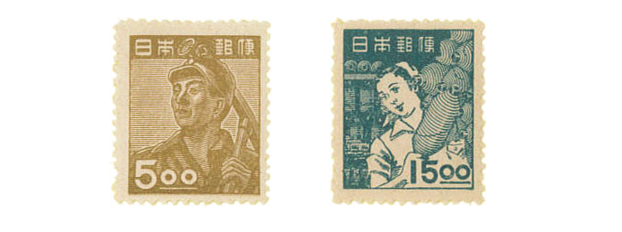戦後復興期の切手 概説(1948~1959)
1-10
Postage Stamps for Postwar Reconstruction Overview 1948 -1959
歴史的背景
1947年(昭和22)から1951年(昭和26)まで、日本はアメリカ政府から「ガりオア奨学金」16億ドル(現在の価値で2兆円)の援助を受けた。また、1950年(昭和25)から1954年迄続いた朝鮮戦争によって、日本は後方基地的な部品供給や輸送機器の修理製造補助などを通して、戦後の経済(産業復興)の機会を得た。 1951年(昭和26)、日本はサンフランシスコ講和条約により、アメリカ占領から再独立した。1948年(昭和23年)逓信文化委員会において日本の戦後再建産業を担う人々を図案化することが決定された。それにより、1948年10月から1949年10月の間、上記12種の切手が発行された。これらの切手には戦後経済変動期を反映して、印刷色・糊などに大きな変化がみられる。1950年以降、印刷技術の進化から、日本の全ての切手の透かしが廃止された。産業図案切手の透かし無し版がその時発行されている。また、産業図案切手のデザインが古くなったため、1950年11月から、改正図案として国宝切手が発行され、1951年から1959年まで、動植物切手(第1次・第2次)が発行された。
参考; 今井修著『日本切手100年小史』 1978.7.10
Historical background
From 1947 (Showa 22) to 1951 (Showa 26), Japan received a $ 1.6 billion “Garior
Korean War, which lasted from 1950 (Showa 25) to 1954,it gave Japan an opportunity for postwar economy (industrial reconstruction) through the supply of parts at the rearbase and the repair and manufacturing assistance of transportation equipment.
In 1951 (Showa 26), Japan became re-independence from the occupation of the United Statesby theSan Francisco Peace Treaty.In 1948 (Showa 23), the Ministry of Communications and Culture Committee decided to design the people who will be responsible for Japan’s postwar reconstruction industry. As a result, industrial design stamps were issuedbetween October 1948 and October 1949. These stamps reflected the postwar economicfluctuation period, and there are major changes in printing colors and glue. Since 1950, due to the evolution of printing technology, watermarks on all Japanese stamps had been abolished. An unwatermarked version of the industrial design stamp was issued at that time. In addition, because the design of industrial stamps became old, nationaltreasure stamps were issued as revised designs from November 1950, and animal andplant stamps (first and second) were issued from 1951 to 1959.
Reference: Osamu Imai, “100 Years of Japanese Stamps”, 1978.7.10.

